Scales are a fundamental part of music, so learning and practicing them is absolutely vital to becoming a successful guitar player. If you’re anything like me when I first started, then you may find the task of learning and practicing scales a little bit on the daunting side. This blog entry will be devoted to offering a few ideas of what you can do to help you master scales. First things first, for those of you who don’t know, a scale is a succession of notes arranged in a pattern of whole steps (the distance of two frets on the fretboard) and half steps (the distance of one fret on the fretboard), (eg. major scale : WWH WWWH). By using the notes of a scale you can create an infinite amount of melodies and chords. Alright now that that’s taken care of, let’s get started!
Learn the Notes on the Fretboard
It’s important to know where all of the notes are on the fretboard, especially on the 6th and 5th strings, since the root of most scales start on those strings. There are dozens of ways you could go about doing this. I highly recommend heading on over to Ricci Adams’ musictheory.net. If you go to where it says trainers and click down to guitar trainer you’ll find a program that will help you to learn your notes. It’s a great little program and I have found that it helps immensely. Try to practice learning your notes a little bit every day.
Learn More Than One Scale Form for Each Scale
Being able to play a scale in multiple positions on the fretboard can mean the difference between being a great player and a mediocre one. Learning many different scale forms in different positions will help to open up the fretboard and give you more options and offer more flexibility when soloing.
Learn the Individual Notes That Make Up a Scale
This is a much more effective way of learning scales rather than simply learning the various scale forms. Knowing exactly what notes make up a scale, and knowing what relationship those notes have to the chord they’re being played over will give you much more control over what you are playing. This is especially true when improvising. A great way to do this is to take a scale that you’re learning and to play it very slowly, ascending and descending, naming each note as you go along. You can also do this by replacing the note names with each note’s scale degree (1, 2, 3, 4, etc.). Then you can start making up little melodies and name the notes (or scale degrees) that you are using.
Get Yourself a Scale Reference Guide
It’s always a good idea to have a way of looking up scales, and there are dozens of books out there that do just that. Personally, I use the Incredible Scale Finder, from Hal Leonard. It has over 1300 scales and it’s designed so that they are all easy to find. But really any book that lists scales should do.
Make Sure You Practice Using a Metronome
I cannot stress the importance of a metronome enough. Practicing scales and other technique exercises while using a metronome allows you to develop a solid sense of timing and helps you to keep scales at a slow pace until you can are capable of playing faster.
Improvise
Creating improvised solos is a great way to practice scales. Pick a scale and play along with the radio, or your favourite CD. You can also check out jamcenter.com, which is a great site that offers a variety of backing tracks in different keys and styles for you to jam along with.




![[ Guitar Tricks ]](http://www.guitartricks.com/assets/fun/120.gt07.gif)
No comments:
Post a Comment